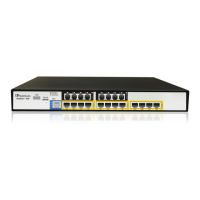User's Manual 260 Document #: LTRT-12809
Mediant 800 MSBR
The IP-to-IP call routing capability is feature-rich, allowing interoperability with different
ITSPs:
Easy and smooth integration with multiple ITSP SIP trunks.
Supports SIP registration and authentication with ITSP servers (on behalf of the
enterprise's IP telephony system) even if the enterprise's IP telephony system does no
support registration and authentication.
Supports SIP-over-UDP, SIP-over-TCP, and SIP-over-TLS transport protocols, one of
which is generally required by the ITSP.
Provides alternative routing to different destinations (to another ITSP or the PSTN)
when the connection with an ITSP network is down.
Provides fallback to the legacy PSTN telephone network upon Internet connection
failure.
Provides Transcoding from G.711 to G.729 coder with the ITSP for bandwidth
reduction.
Supports SRTP, providing voice traffic security toward the ITSP.
IP-to-IP routing can be used in combination with the regular Gateway application. For
example, an incoming IP call can be sent to an E1/T1 span or it can be forwarded to
an IP destination.
Therefore, the device provides the ideal interface between the enterprise IP-PBX and the
ITSP SIP trunk.
The device's IP-to-IP application handles and terminates SIP methods and responses at
each leg independently:
Initiating-dialog INVITE: terminated at one leg and initiated on the other leg,
180\182\183\200\4xx uses the same logic and same limitations, in some cases the
result may be a different response code.
OPTIONS: terminated at each leg independently.
INFO: only specific INFO’s (such as DTMF) are handled; other types are omitted.
UPDATE: terminated at each leg independently and may cause only changes in the
RTP flow - Hold\Retrieve are the only exceptions that traverse the two legs.
Re-INVITE: terminated at each leg independently and may cause only changes in the
RTP flow - Hold\Retrieve are the only exceptions that traverse the two legs.
PRACK: terminated at each leg independently.
REFER (within a dialog): terminated at each leg independently.
3xx Responses: terminated at each leg independently.
401\407 responses to initial INVITE: in case the back-to-back session is associated
with an Account, the responses is terminated at the receiving leg; in other cases, the
responses are passed transparently.
REGISTER: handled only in cases associated with a User-type IP Group - Contact,
To, From specific parameters are omitted.
22.1 Theory of Operation
The device's IP-to-IP SIP session is performed by implementing Back-to-Back User Agent
(B2BUA). The device acts as a user agent for both ends (legs) of the SIP call (from call
establishment to termination). The session negotiation is performed independently for each
call leg, using global parameters such as coders or using IP Profiles associated with each
call leg to assign different configuration behaviors for these two IP-to-IP call legs.
For the maximum number of supported IP-to-IP sessions, see DSP Templates on page
993.
The device also supports NAT traversal for SIP clients behind NAT, where the device is
defined with a global IP address.

